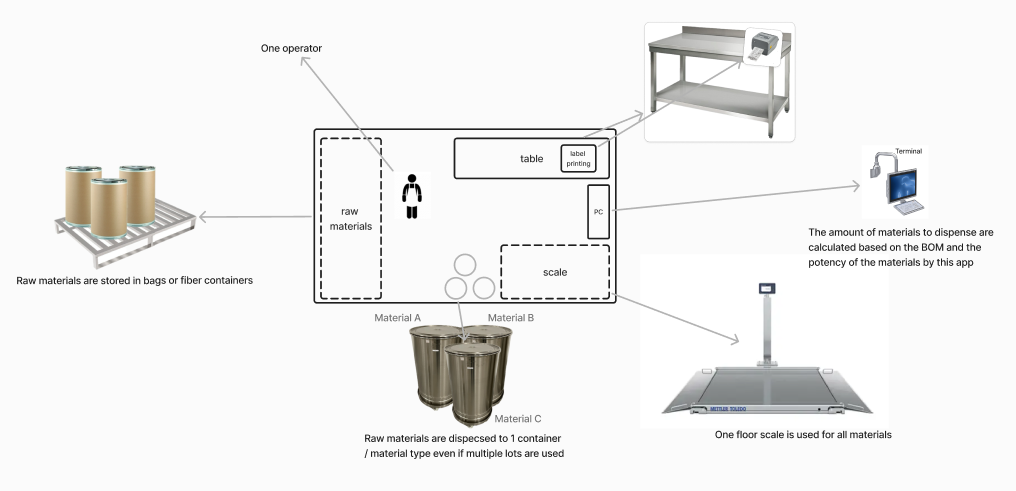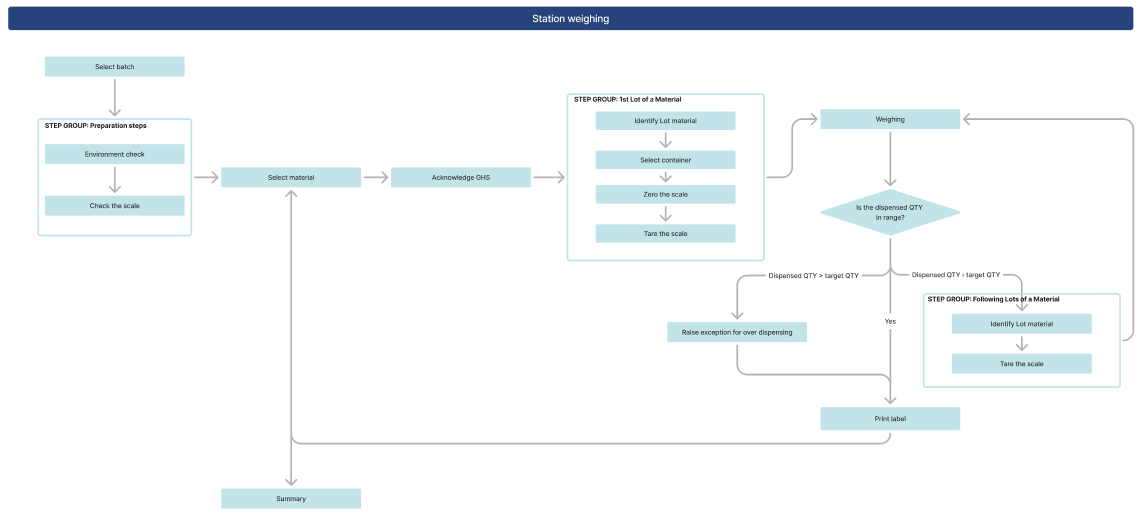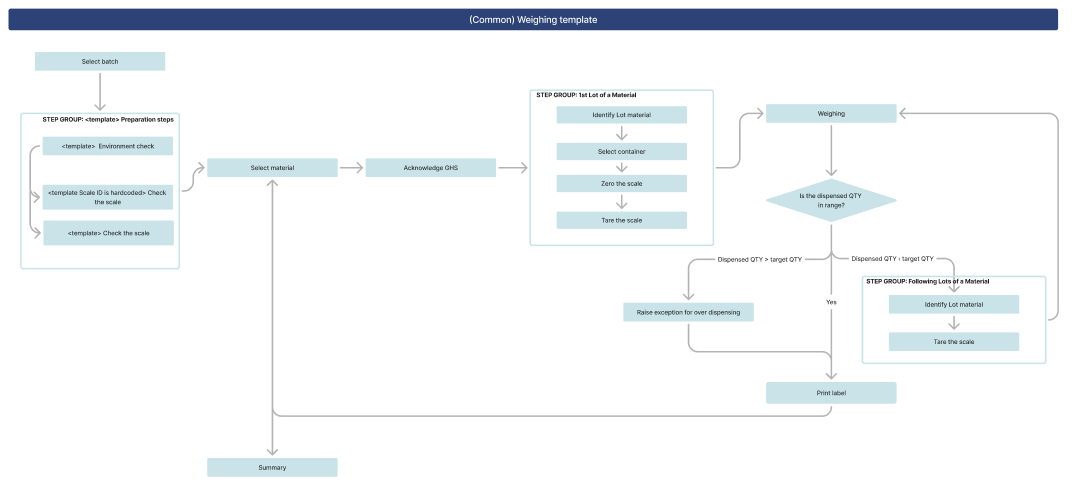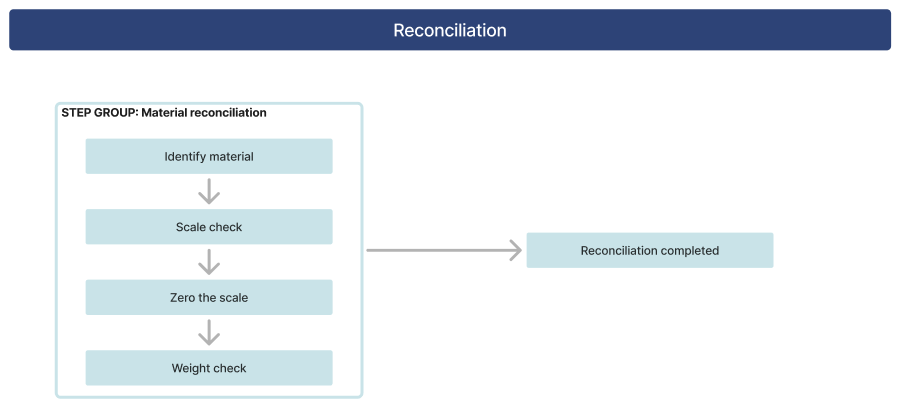:::(Info) (Library Link)Descargue el grupo de aplicaciones de pesaje y dispensación.Este grupo de aplicaciones contiene 1 aplicación pre-validada: Estación de Pesaje:::
Conozca las funciones principales del grupo de aplicaciones Pesar y dispensar, cómo utilizar estas funcionalidades y cómo las aplicaciones pueden trabajar juntas dentro del grupo. El artículo también incluye los pasos esenciales de configuración necesarios para utilizar las aplicaciones, así como las opciones de personalización.Este grupo de aplicaciones forma parte de Composable MES for Pharma App suite.This App Group contains one pre-validated app, Station Weighing.
Alcance físico

Los materiales se entregan en palés desde el almacén a la zona de dispensación. La aplicación de dispensación está totalmente desarrollada en la plataforma Tulip. Para garantizar que los materiales físicos se representan con precisión en la aplicación, se utiliza la aplicación de recepción de materiales.
Dentro de la aplicación de dispensación, puede medir los materiales para un lote específico, colocando cada tipo de material en su propio contenedor. La aplicación también permite dispensar varios lotes.
Además, la aplicación calcula automáticamente la potencia del principio activo durante el proceso de dispensación. Si se necesitan materiales compensadores, la aplicación calculará la cantidad exacta necesaria una vez medido el principio activo, garantizando que todo esté ajustado con precisión.
La aplicación realiza un seguimiento del estado de las herramientas que se utilizan, como la báscula y los recipientes. Garantiza que sólo se utilicen básculas limpias y calibradas. Para facilitar la comprobación diaria y la documentación del historial de la balanza, la aplicación Prueba de sensibilidad diaria está disponible para guiarle en el proceso.
Tablas de tulipanes utilizadas en el grupo de aplicaciones
La principal tabla utilizada por esta aplicación, aparte de la tabla de Lotes, es la tabla de Materiales y la lista de Materiales.
La tabla Materiales contiene la copia digital de los materiales físicos, mientras que la tabla Lista de materiales almacena la lista de materiales a dispensar para un lote determinado, junto con sus cantidades teóricas. Si se dispone de un sistema ERP, no es necesario almacenar esta información de forma redundante. Un conector entre Tulip y el sistema ERP permite recuperar estos datos directamente.
Otras tablas utilizadas en la aplicación son GHS, Scales, Comments & Exceptions y Containers. Las dos tablas que permiten el correcto enrutamiento entre la aplicación de pesaje en este grupo de aplicaciones son las tablas Stations y Process Flow.
:::(Info) Aprenda más sobre las tablas de Tulip's Common Data Model (CDM) para Pharma aquí:::
Aplicaciones en el Grupo de Aplicaciones de Pesaje y Dispensación
Aplicación de Pesaje en Estación
Aplicación prevalidada
::: (info) ()PRE-VALIDADAEstaaplicación está pre-validada. Puede descargar un Diagrama de Flujo Operativo, una Evaluación de Riesgos y un Plan de Pruebas para apoyar sus esfuerzos de validación. :::

Una aplicación de pesaje en estación es un ejemplo de utilización de una báscula específica para el proceso de pesaje y dispensación. En este proceso, los materiales del lote se pesan uno tras otro. La aplicación admite el pesaje de materiales de varios lotes para el mismo artículo de material. Los diferentes lotes se miden en el mismo recipiente para ese artículo. La aplicación evita el uso de básculas sucias o sin calibrar, lo que obligará al usuario a utilizar la aplicación de comprobación diaria. Además, controla las fechas de caducidad de los lotes identificados y bloquea el uso de materiales caducados.
Durante el proceso de pesaje, la aplicación calcula automáticamente la cantidad de material necesaria en función de la potencia del material identificado. En caso de sobrepeso, la aplicación se desplaza al paso Elevar excepción por sobredosificación, donde se genera una excepción. Una vez pesados todos los materiales, la aplicación pasa al paso de resumen, que ofrece una visión general del proceso de pesaje. Tras la confirmación, la aplicación vuelve a la aplicación de seguimiento de lotes.
Plantilla de pesaje

La plantilla de pesaje es una aplicación generalizada con ayudantes en la aplicación que guían a los usuarios sobre qué secciones necesitan configuración. Los pasos etiquetados como "plantilla" ofrecen varias opciones para una etapa específica, como la identificación de la báscula. En la plantilla se han incluido disparadores de ejemplo para conectarse a las básculas Mettler a través del puerto serie, enviar las instrucciones correctas o recibir datos de la báscula. Sin embargo, ninguno de estos disparadores funcionará sin la configuración adecuada, como especificar el campo identificador y el puerto COM correcto en los ajustes del disparador.
Prueba de sensibilidad diaria

Esta aplicación está diseñada para simplificar las pruebas de sensibilidad diarias de las balanzas y documentarlas. Ofrece dos opciones para realizar las comprobaciones diarias. La primera opción utiliza la función de autocalibración de la báscula y la documenta en la aplicación, por lo que el uso de un peso de prueba externo es opcional. La segunda opción permite realizar la prueba con un peso de prueba externo, proporcionado como valor estático en la app. La aplicación evalúa automáticamente los resultados de la prueba basándose en los márgenes de tolerancia de la pesa de prueba seleccionada y en los valores introducidos manualmente por el usuario. Si desea eliminar la introducción manual, se requiere la integración de la báscula.
Recibo de material

La Recepción de Material es una sencilla aplicación diseñada para digitalizar y crear un gemelo digital de los materiales físicos recibidos del almacén, cargando esta información en la tabla Tulip. Esto garantiza que otras aplicaciones tengan acceso a los datos de material necesarios para apoyar la ejecución del proceso. Una vez introducidos todos los parámetros de material necesarios, la aplicación guarda los datos en la tabla Materiales.
Reconciliación

Durante el proceso de fabricación, la cantidad física real de materiales puede diferir de los valores almacenados digitalmente. La aplicación Reconciliación ayuda a verificar y corregir estas discrepancias. Tras identificar el material, se selecciona la balanza adecuada para su uso. La aplicación garantiza que sólo estén disponibles para su uso las básculas con el estado correcto. Una vez medido el material, la aplicación actualiza la tabla con el peso real del material.
Si se utiliza un sistema ERP, estas actualizaciones pueden sincronizarse directamente con el sistema ERP conectado a Tulip, una vez establecido el conector necesario.
Configuración y personalización
Las aplicaciones de este grupo disponen de las configuraciones necesarias para implementarlas en su sistema de aplicaciones. También existen opciones para personalizar los componentes de la app según sus necesidades específicas.
:::(Info)Learn more about the Configuración general del grupo deaplicaciones composable MES for Pharma aquí:::
Conexión con otras aplicaciones
Mezcla
Los materiales pesados en la aplicación Station Weighing se utilizan en la aplicación Blending.
